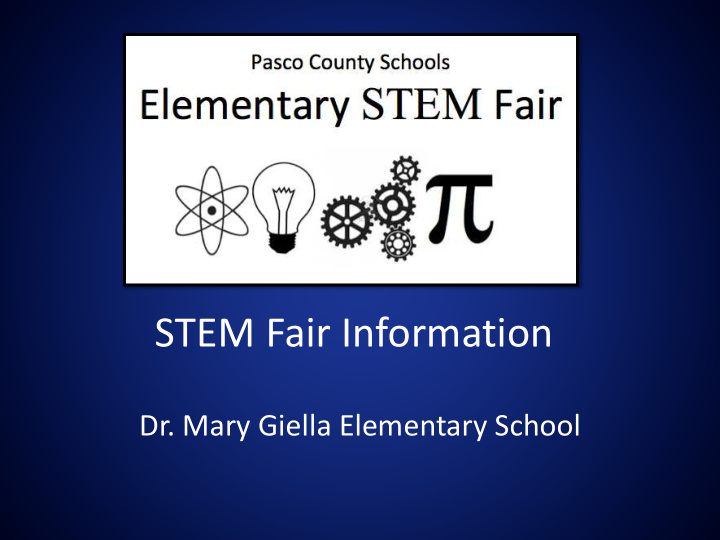



STEM Fair Information Dr. Mary Giella Elementary School
What is STEM? • Science • Technology • Engineering • Mathematics
Why a STEM Fair? • Providing students opportunities to make meaningful connections to the real world is critical as we develop the skills, behaviors, and dispositions necessary for college, career, and life readiness. • Developing a S.T.E.M. (Science, Technology, Engineering, and Mathematics) Fair investigation will provide students the opportunity to use science knowledge and skills just as scientists do in the real world.
Skills used in STEM Fair include: • Writing clearly • Communicating information effectively • Collecting and interpreting data • Using evidence to justify your thinking • Managing time • Providing opportunities to ask “why” leading to the development of an experiment or designing of a solution/innovation
Supporting your child with STEM Fair • Parents play a critical role in supporting their child throughout the STEM Fair process. • Be interested, encouraging and positive • Supervise and use resources that ensure the SAFETY of both your child and tested organisms.
Try to ask questions rather than give answers: • Questions help place responsibility on your child. • Questions help explore the dimensions of the problem. • Questions draw solutions from your child. • Questions communicate trust and confidence. • Questions help develop your child’s thinking and problem solving skills.
Sample Guiding Questions: • Why? • How do you know that? • What do you want to happen? • What would happen if…? • What other things could you try? • Explain or assist in finding resources to explain concepts that are difficult to understand.
Research Plan Your child’s teacher will provide the booklet • Provides clarification and guidance throughout your child’s investigations. • Helps your child stay organized • Your child MAY need to keep an ADDITIONAL project log or journal. This could include dates and notes of everything that is done and read in connection to the investigation.
Getting Started: Choosing an Investigation • Your child needs to be excited about their investigation, guide them to investigate something they are interested in. • Research: Your child needs to gather information to help them develop their investigation
Example Question/Problem • Problem I am going to solve : “I am constantly losing things out of my pant pockets. How can I create a pant pocket that keeps items inside?” – This investigation has the student design/engineer something and then test it to help them solve their problem. Invention or Innovation • Question I am going to answer : “Which brand of diaper is the most absorbent?” experiment
Example Hypotheses • Question: If I put 30 mL of water in the Huggies diaper, then it will absorb the most water because Huggies diapers have an extra layer of polyfiber material. • Problem: If I create a magnetic pocket casing, then I will lose fewer items out of my pockets because magnets provide a tight seal due to their characteristics.
Putting It Into Action: Procedure • The purpose of the procedure is so other scientists and engineers can replicate your investigation. DETAIL, DETAIL, DETAIL. • Make sure to share all steps completed during the investigation and/or design of the solution. • It is okay if you begin your procedure and realize you may need to change something. This happens to scientists and engineers all the time.
Variables A variable is a fancy word for things that you will be changing or keeping the same throughout your investigation. There are 3 types of variables: • Independent: The one variable that will be changed • Dependent: The variable that will show an effect measurable • Constants: All the things that will be kept the same throughout the investigation to make sure it’s valid
Example Variables for Diaper Question • Independent: different brand of diapers that are being tested (Huggies, Pampers, Luvs) • Dependent: the amount of water absorbed (measuring using mL) by each brand of diaper • Constants: temperature of the water, location in the diaper in which water is poured
Example Variables for Pant Pocket Problem • Independent: different types of materials tested to create the pocket casing This is the what you change, and you can only change 1 thing. • Dependent: the number of shakes the pant pocket can withstand before losing its contents • It must be measureable • Constants: same pair of pants and sized pocket, same items placed in the pocket casing
Collecting Data • As you investigate your problem be sure to collect data using a chart or table in your log or plan book • This will help you draw conclusions when you are finished with your experiment
Graphing Results: Communicating Our Data (Create a graph) website Paper Towel Types of Graphs: Testing 7 Bar- Compares different things 6 6 5 Line- Shows progress over time 5 Number of paper towels Circle- Parts of a Whole 4 3 3 2 2 Make sure title and subtitles are 1 labeled. 0 Number of Ounces Absorbed
Conclusion and Abstract: Putting It All Together n What did you learn from the experiment? n Did you prove your hypothesis? n Why-why not? n What problems did you have? n How is it applicable to real life? n What can the results be used for? n How can I use the knowledge I have gained from the experiment? n What would you do differently next time?
Safety and Display • The following items are not permitted to be displayed with your backboard: – Any glassware including containers that contain liquids – Any sharp items or edges. These could be hazardous to other students – Open flames or anything combustible – Mold regardless if it is in a container (Take Pictures) – No food (human or animal) – There will not be any electricity provided
Pasco County Elementary School S.T.E.M. Fair • Who: Representatives from each elementary school (Grades 3-5) • When: Saturday, April 15, 2017 • Where: River Ridge High School
Recommend
More recommend